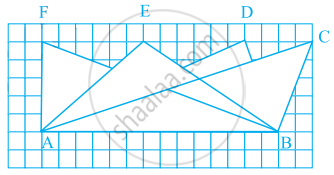Advertisements
Advertisements
Question
The area of a triangle is 5 sq units. Two of its vertices are (2, 1) and (3, –2). If the third vertex is (`7/2`, y). Find the value of y
Solution
Let `A(x_1,y_1) = A(2,1), B(x_2, y_2) = B(3,-2)` and `C(x_3,y_3) = C(7/2,y)`
Now
Area(ΔABC) =`1/2|x_1(y_2 - y_3) + x_2(y_3-y_1) + x_3(y_1 - y_2)|`
`=>5 = 1/2|2(-2-y) + 3(y - 1) + 7/2(1+2)|`
`=> 10 = |-4-2y+3y - 3 + 21/2|`
`=>10 = |y + 7/2|`
`=> 10 = y + 7/2` or `-10 = y + 7/2`
`=> y = 13/2` or `y = (-27)/2`
Hence `y = 13/2 or (-27)/2`
APPEARS IN
RELATED QUESTIONS
The vertices of ∆ABC = are A (4, 6), B(1, 5) and C(7, 2). A line is drawn to intersect sides AB and AC at D and E respectively such that `\frac{AD}{AB}=\frac{AE}{AC}=\frac{1}{4}` .Calculate the area of ∆ADE and compare it with the area of ∆ABC
If A(4, –6), B(3, –2) and C(5, 2) are the vertices of ∆ABC, then verify the fact that a median of a triangle ABC divides it into two triangle of equal areas.
Find equation of line joining (1, 2) and (3, 6) using the determinant.
Find the area of the quadrilaterals, the coordinates of whose vertices are
(−3, 2), (5, 4), (7, −6) and (−5, −4)
Find the area of a triangle whose sides are respectively 150 cm, 120 cm and 200 cm ?
Find the area of a triangle two sides of which are 18 cm and 10 cm and the perimeter is 42cm ?
Find the area of Δ ABC whose vertices are:
A (1,2) B (-2,3) and C (-3,-4)
If the area of triangle ABC formed by A(x, y), B(1, 2) and C(2, 1) is 6 square units, then prove that x + y = 15 ?
Find the coordinates of the point Q on the x-axis which lies on the perpendicular bisector of the line segment joining the points A(–5, –2) and B(4, –2). Name the type of triangle formed by the points Q, A and B.
Observe all the four triangles FAB, EAB, DAB and CAB as shown in the given figure.

- All triangles have the same base and the same altitude.
- All triangles are congruent.
- All triangles are equal in area.
- All triangles may not have the same perimeter.
